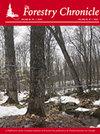Modelling wood density and modulus of elasticity in white spruce plantations in Eastern Québec
IF 0.8
4区 农林科学
Q3 FORESTRY
引用次数: 1
Abstract
Forest managers have to take into account multiple objectives such as stand yield, wood quality attributes, ecological constraints and social considerations when making their decisions. The objective of the present study is to build (i) a dynamicmodulus of elasticity (MOEdyₙ) model and (ii) a core wood density (WDcₒᵣₑ) model for white spruce plantations in theBas-Saint-Laurent Region (Quebec, Canada) to quantify their inter- and intra-stand variations in order for managers tobetter weigh their different options. Using data obtained from 54 sample plots in 31 white spruce plantations from Eastern Quebec, the MOEdyₙ of 143 trees and the WDcₒᵣₑ of 162 trees were analysed. Dendrometric and stand variables wereused to build a MOEdyₙ linear mixed-effect model and a WD multiple linear regression model. The MOEdyₙ model explained 66.8% of the total variation, 1.1% of which originated from inter-stand variations. MOEdyₙ was proportionalto diameter at breast height (DBH) and non-linearly decreased with tree growth rate. The WDcₒᵣₑ model explained 16.0%of the total variation. The intra-stand variations were represented by a negative relationship between WDcₒᵣₑ and growthrate. Inter-stand variations were accounted for by site index and altitude. The performance of the MOEdyₙ model was satisfactory and in accordance with the literature. However, the WDcₒᵣₑ model was below standard, mainly as a consequenceof unaccounted intra-individual variations. Nonetheless, raw simulations using these models suggest that white sprucewood from plantations may benefit from intensive forest management.魁北克东部白云杉人工林的木材密度和弹性模量建模
森林管理者在做出决策时必须考虑多种目标,如林分产量、木材质量属性、生态约束和社会因素。本研究的目的是建立(i)动态弹性模量(MOEdyₙ) 模型和(ii)芯材密度(WDcₒᵣₑ) 下圣罗兰地区(加拿大魁北克省)白云杉种植园的模型,以量化其林分间和林分内的变化,以便管理者权衡他们的不同选择。利用从魁北克东部31个白云杉种植园的54个样地获得的数据ₙ 143棵树和WDcₒᵣₑ 对162棵树进行了分析。树木测量和林分变量用于构建MOEdyₙ 线性混合效应模型和WD多元线性回归模型。MOEdyₙ 该模型解释了66.8%的变异,其中1.1%的变异源于林分间变异。MOEdyₙ 与胸径(DBH)成正比,并随树木生长速率非线性下降。WDcₒᵣₑ 模型解释了16.0%的总变化。林分内变异表现为WDc之间的负相关ₒᵣₑ 和增长率。林分间的变化是由场地指数和海拔高度来解释的。MOEdy的性能ₙ 模型令人满意,与文献相符。然而,WDcₒᵣₑ 该模型低于标准,主要是由于未解释的个体内部变异。尽管如此,使用这些模型进行的原始模拟表明,种植园的白云杉木可能会从密集的森林管理中受益。
本文章由计算机程序翻译,如有差异,请以英文原文为准。
求助全文
约1分钟内获得全文
求助全文
来源期刊

Forestry Chronicle
农林科学-林学
CiteScore
1.20
自引率
0.00%
发文量
6
审稿时长
18-36 weeks
期刊介绍:
The Canadian Institute of Forestry has published The Forestry Chronicle, a professional and scientific forestry journal, since 1925. The Forestry Chronicle is published to provide information to forest practitioners about professional and scientific management of forests and their resources. The Forestry Chronicle provides forest practitioners in Canada and around the world with a means to communicate with their peers in the professional community.
 求助内容:
求助内容: 应助结果提醒方式:
应助结果提醒方式:


